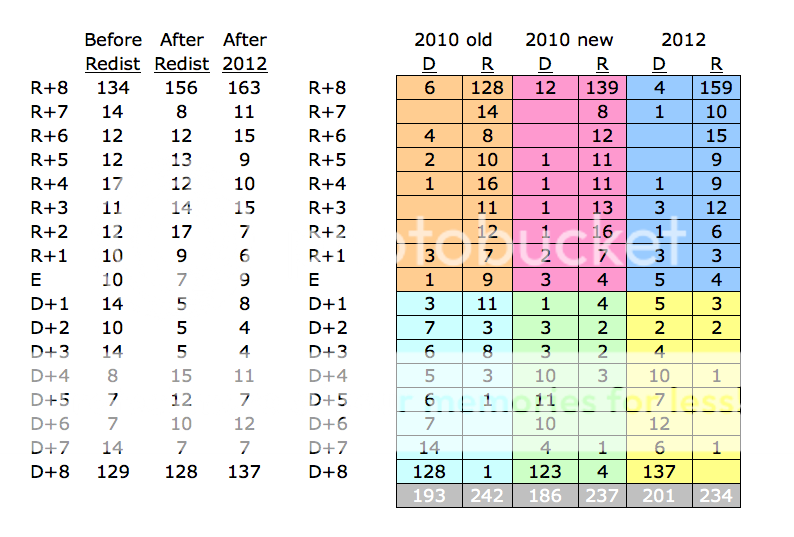|
|
"A comprehensive, collaborative elections resource."
|
2012 House by PVI and Party
|
|---|
| Parent(s) |
Event
|
| Contributor | Scott³ |
| Last Edited | Scott³ Feb 23, 2013 05:23pm |
| Logged |
1
[Older]
|
| Category | Analysis |
| Author | Left Coast Libertarian |
| News Date | Thursday, February 21, 2013 11:00:00 PM UTC0:0 |
| Description | "There are still a few counties we don't have final Obama-Romney numbers for by congressional district, but we can estimate those numbers in order to give us an overview of the districts on the charts below."

The chart on the left shows us how great redistricting went for the GOP. Before redistricting Republicans had 160 districts that were R+6 or better with 2008 numbers. After that they had 176. The 2012 numbers show that there are now 189 such districts.
The numbers also got better for Democrats. Their D+6 or better went from 150 to 145 to 156.
So we have two possible factors for this. 1) Whoever was doing partisan redistricting picked up on not only where the vote had been, but they also figured out where it was going. 2) Republicans and Democrats are becoming more clustered.
Competitive seats, defined as those that are no more than +3, went from 81 before redistricting to 62 after it and now 53 after the 2012 election.
The majority will be difficult for Democrats. There are 223 seats which are R+3 or better. Republicans hold 214 of them. So Democrats could get the majority if they won every seats that was R+2 or more Democratic and held 6 of the 9. It's difficult to see how anyone could run the table like that. So Democrats would have to start capturing R+3 and R+4 seats for a majority. If they can hold all their seats, they could get there by winning 41% of Republican seats which are R+4 or less. That doesn't sound that hard, but they only 5 of the 32 R+2-4 seats after a good election for them.
A neutral year should produce a net gain for Republicans. Democrats hold 18 even to Republican leaning seats, while the GOP holds only 11 even or Democratic leaning seats. Perhaps the most notable thing is how small those numbers are. Here are the Republican leaning seats held by Democrats are recent elections:
2004: 31
2008: 69
2010: 17
2012: 18 |
| Share |
|
|
2¢
|
|
| Article | Read Full Article |
|
|

